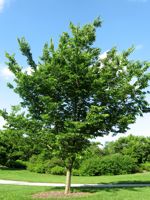Mon-Fri 9am - 5pm Mountain time
Common Hackberry vs Green Ash
Celtis occidentalis
Fraxinus pennsylvanica
The Common Hackberry is a medium-sized deciduous tree that resembles the American Elm but is immune to Dutch Elm Disease. They are versatile and can adapt to a variety of growing conditions.
It produces purple-red, berry-like fruit with a large seed in the center. Both the sweet flesh, which tastes similar to dates, and the crunchy seed are edible. The fruit remains on the tree throughout the winter, offering a valuable food source for birds and other wildlife.
The Common Hackberry can also be a great addition to a pollinator garden. The tree itself is a host for the larvae of several butterfly species and the flowers provide a source of pollen and nectar.
Green ash is a fast growing tree with incredible golden yellow leaves in fall. This tree is native to the prairies and is well suited for drought and cold. Green ash can also tolerate soil compaction, periods of flooding and a wide variety of soils including alkaline. This makes green ash ideally suited for use in urban environments.
Common Hackberry Quick Facts
Green Ash Quick Facts
In row spacing: 1.8 - 2.4 m (6 - 8 ft)

